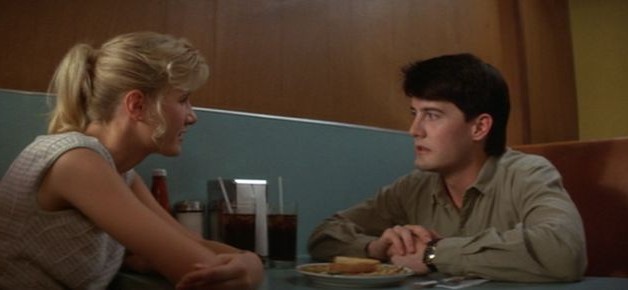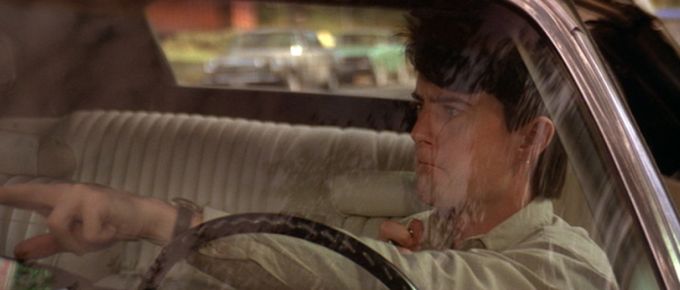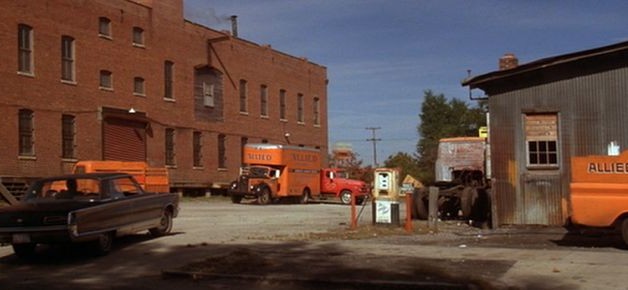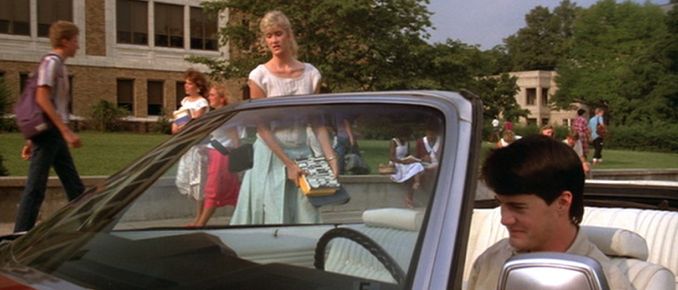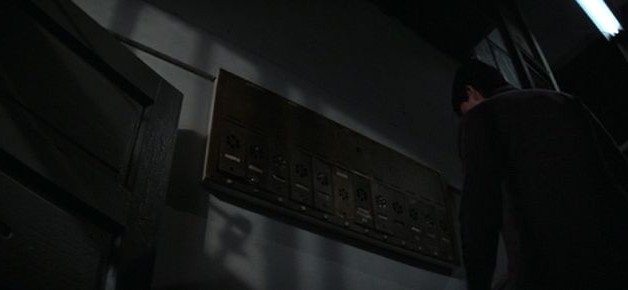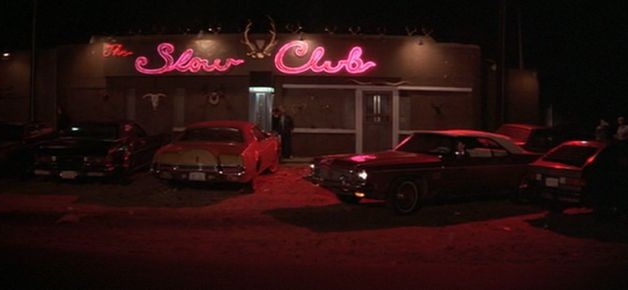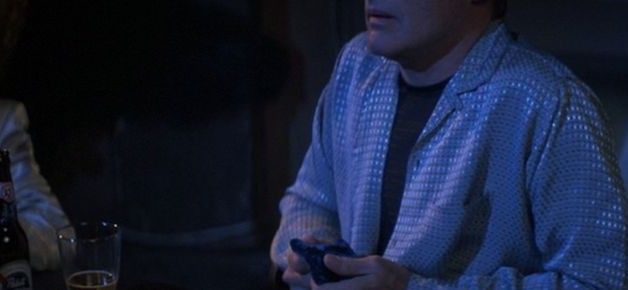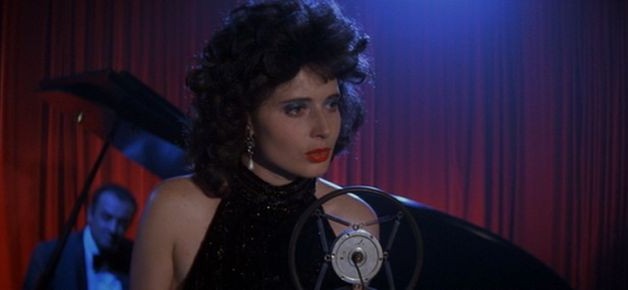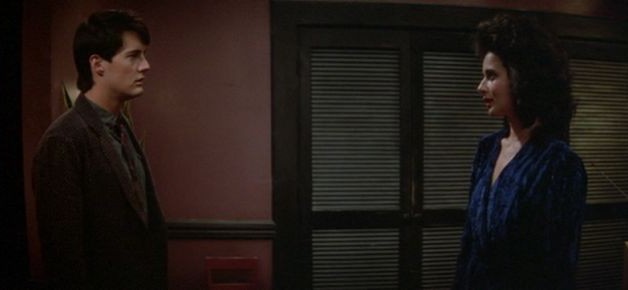The Blue Velvet Project
Blue Velvet, 47 seconds at a time by Nicholas Rombes
-
The Blue Velvet Project, #83 (Part 2)
Second #3901, 65:01 (pt. 2) And so, for the first time in this project, two posts on the same frame. Why? Most of all, it’s because of the brown, paneled wall to Sandy’s left. A wall where you think a window ought to be. Why do you think this? What gives rise to the suspicion that a wall artificially covers (hides) a window? Probably because it’s linked to the first time Sandy and Jeffrey were together at Arlene’s (covered in post #25). Even though it’s possible that they are simply at a different booth, one framed by a wall and… Read more
-
 The Blue Velvet Project, #83 (Part 1)
The Blue Velvet Project, #83 (Part 1)
Second #3901, 65:01 1. Jeffrey: “I’m seeing something that was always hidden.” 2. J. G. Ballard, from Concrete Island, 1974: When he reached the embankment and searched for the message he had scrawled on the white flank of the caisson, he found that all the letters had been obliterated. 3. André Breton, from “Manifesto of Surrealism,” 1924: Under the pretense of civilization an progress, we have managed to banish from the mind everything that may rightly or wrongly be termed superstition, or fancy . . . It was, apparently, by pure chance that a part of our mental world which… Read more
-
 The Blue Velvet Project, #82
The Blue Velvet Project, #82
Second #3854, 64:14 “I saw The Yellow Man come out and meet up with a well-dressed man carrying an alligator briefcase,” Jeffrey tells Sandy, as we see him snapping a picture with his rigged-up camera-in-a-shoebox, a strange, analog echo of the Lumière brothers’ early motion picture camera. The sequence is reminiscent of a similar one (also involving doubles) in Brian De Palma’s Dressed to Kill, when Kate’s (Angie Dickinson’s) son Peter (Keith Gordon) has suspicions about Dr. Elliott (Michael Caine) and concocts a camera set-up to photograph the entry to his office. The whole operation is so dead-on: the detective’s… Read more
-
 The Blue Velvet Project, #81
The Blue Velvet Project, #81
Second #3807, 63:27 1. “Today,” Jeffrey tells Sandy at Arlene’s, as we see a flashback of what he’s describing, “I staked out Frank’s place with a camera. Now, there’s another man involved in all this. I call him The Yellow Man.” These shots, in the bright of day, are some of the most quietly beautiful in the film with their burnt-orange 1940s-era Allied Vans, as if Walker Evans photographs had switched to color. 2. In Derek Raymond’s novel The Devil’s Home On Leave, the nameless Detective Sergeant recalls a terrible dream: But in the night I dreamed that two figures… Read more
-
 The Blue Velvet Project, #80
The Blue Velvet Project, #80
Second #3760, 62:40 Jeffrey, having arrived later than expected to pick up Sandy after school, has just been spotted by Sandy’s boyfriend Mike, who is doing a variation of jumping jack exercises with the football team (in full uniform, including helmets) on a tennis court across the street in a scene that oddly predicts the “Do the Locomotion” scene in Inland Empire. We are back in the sunlight now, the deeply coded normalcy of high school, the girls in their long skirts recalling the teenage rebel movies of the 1950s. The frame captures no one looking at anyone. Dead gazes.… Read more
-
 The Blue Velvet Project, #79
The Blue Velvet Project, #79
Second #3713, 61:53 Jeffrey, having followed Frank to a building, sneaks inside at night to confirm that it is, indeed, where Frank lives. The shot only lasts a few seconds, and serves as a bridge between what has just come before (Jeffrey’s cloaked, nighttime pursuit of Frank) and what will come after (the scene at Arlene’s Diner with Sandy as he recalls to her witnessing the actions of the Yellow Man, the Well-Dressed Man, and Frank). The frame is pure Expressionism as Jeffrey finds himself searching for Frank’s name on the mailboxes in a low-angle shot whose shadows and lines… Read more
-
 The Blue Velvet Project, #78
The Blue Velvet Project, #78
Second #3666, 61:06 After Frank and his gang leave the Slow Club, Jeffrey follows them. He is a detective, now. The scene is bathed in hellish red. The slow rumble of thunder ratchets up the tension. There is no one for Jeffrey, neither Dorothy nor Sandy. Not now, in the silence of his car. In fact, the movie has carried itself forward without functional dialogue for a while; it’s become pure cinema, where the images and sounds render dialogue obsolete, because of what use is dialogue in the bloodlands? In 2666, by Roberto Bolaño, a character, Norton, repeated, in German,… Read more
-
 The Blue Velvet Project, #77
The Blue Velvet Project, #77
Second #3619, 60:19 See shot 9 from the previous post (#76). Frank, here, is someone caught between the hipsterism of the 1940s and the 1990s, his Pabst Blue Ribbon signifying the working man’s authenticity as opposed to the soft, foreign Heineken, the baby-faced college boy’s beer. And yet Frank aspires to suaveness in his soft nightclub shirt and beer poured into a glass, not drunk out of a bottle. Frank is a slave to a fixed idea. When he watches Dorothy on the stage, what does he really see? What if there’s something in Dorothy that’s only available to him,… Read more
-
 The Blue Velvet Project, #76
The Blue Velvet Project, #76
Second #3572, 59:32 Back at the Slow Club, Jeffrey has just poured himself a Heineken, and Dorothy has noticed something that has caused a shadow of fear to cross her face. In a subtle relay of looks captured in nine shots that last just over one minute, this happens: Shot 1: Jeffrey, having poured a Heineken, watches Dorothy perform “Blue Velvet.” Shot 2: (second #3572, the frame above) Dorothy sees something in the audience that spooks her. Shot 3: Jeffrey notices Dorothy’s fear, and turns his head to where she is looking. Shot 4: We see Frank, the object of… Read more
-
 The Blue Velvet Project, #75
The Blue Velvet Project, #75
Second #3525, #58:45 A classic two-shot, Jeffrey and Dorothy looking at each other across the open space of the screen. Dorothy is framed within the frame by the impossible closet (a sort of black screen) in the background. No longer dressed in black, Jeffrey’s character begins to separate itself from the hinted-at idea that he is somehow another, younger version of Frank. Although Blue Velvet is not alone in taking viewers into a sealed-off fictive world, it does so, strangely, by referring to the outside, “real” world (our world) not directly, but indirectly, through archetypes. There is a detective, a… Read more
